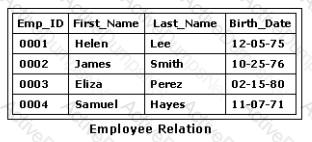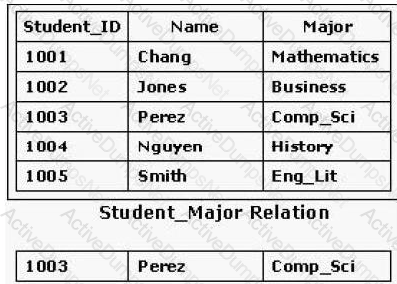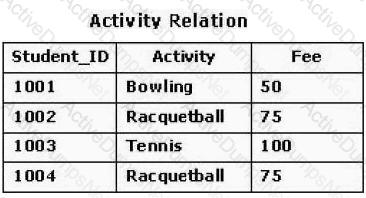CIW 1D0-541 CIW v5 Database Design Specialist Exam Practice Test
CIW v5 Database Design Specialist Questions and Answers
Which of the following best describes the ON DELETE NO ACTION referential integrity constraint?
Which subset of Structured Query Language (SQL) is used to create and name database entities?
In which situation would the DBMS use a serial schedule to execute the transactions?
Which of the following is a characteristic of the three-tier database architecture?
Which of the following describes two desirable characteristics of a primary key?
For the Employee relation shown in the exhibit, which set of column value holds the complete tuple for the employee named James Smith?

Consider the following relation definitions:
STUDENT(
Student_Number: integer NOT NULL
Name: variable length character string length 20)
Primary Key Student_Number
HOUSING(
Housing_ID: integer NOT NULL
Student_Number: integer NOT NULL
Building: variable length character string length 25)
Primary Key Housing_ID
Foreign Key Student_Number References STUDENT(Student_Number)
ON DELETE NO ACTION
ON UPDATE CASCADE
What are the referential constraints for the relations defined in these relation definitions?
Which type of dependency occurs when one attribute of a composite key is removed and the dependency still exists?
Which concurrency control method should be used only when conflicts between transactions rarely occur?
What is a relational database domain?
You enterprise must decide whether to use a database management system. Which of the following lists four advantages of using a DBMS?
Consider the table shown in the exhibit. Which relational algebraic operation would return Row 3?

Your database administrator has disallowed a group of users from making alterations to the Employees table in your corporate database. The users, known as Group_2, previously had full privileges with the Employees table. Which of the following SQL statements properly removes any alteration privileges from Group_2?
What is the highest normal form of the relation(s) shown in the exhibit?

The exhibit shows a table called Activity Relation that relates a unique student identification number with a sports activity and a fee for participating in that activity. A student can participate in only one activity. The key for the relation is Student_ID. What consequence would occur if the tuple for Student_ID 1001 were removed?

Your enterprise has created a database and database application. The testing phase for the project has started. Which of the following best describes white-box testing of the projects software?
Which term describes the management of simultaneous transactions to prevent conflicts?
Which three pieces of information did E.F. Codd describe as necessary to retrieve a data value from a relational database?
